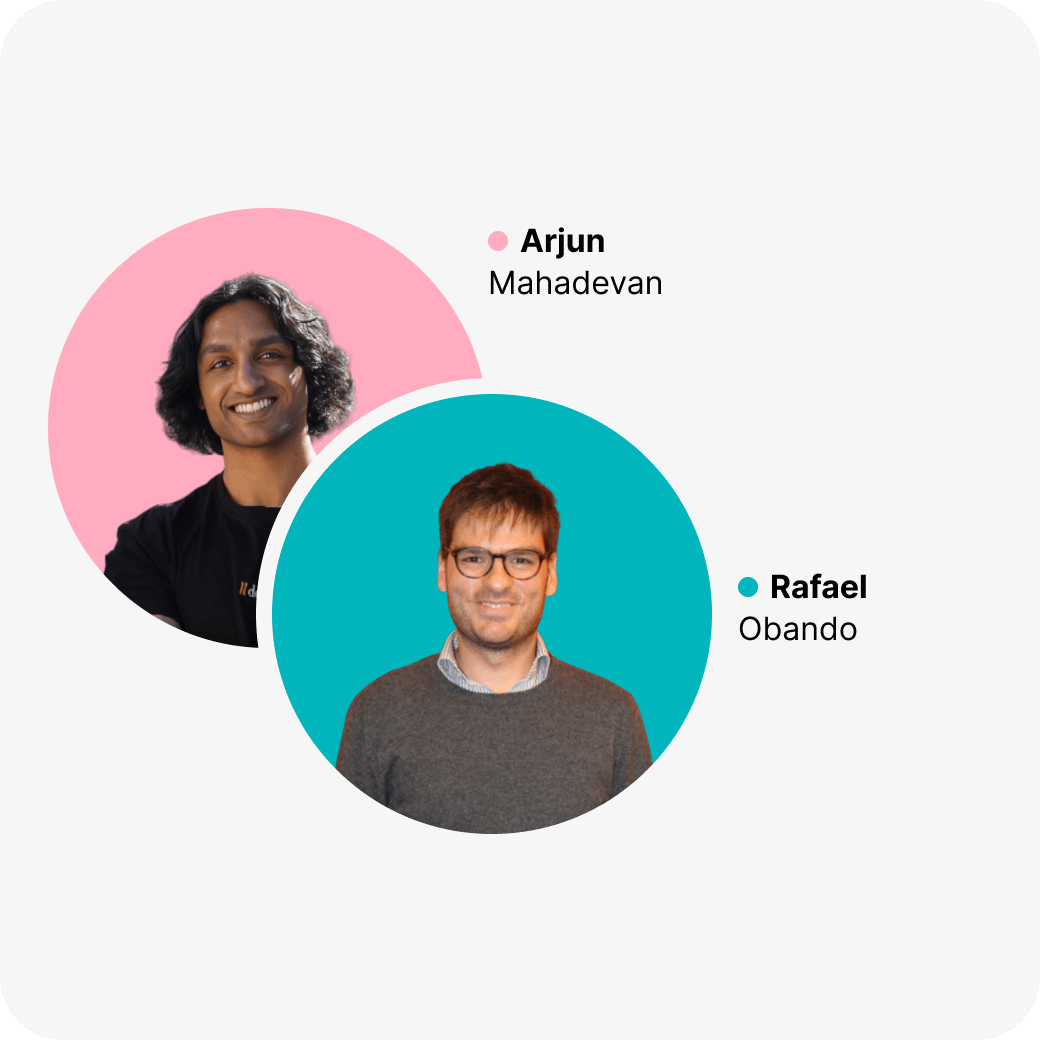Events
Attract Customers with Inbound Marketing
January 11, 2024
5:00 pm - 6:30 pm ET


Missed the live event?
Watch the replay!
Inbound marketing offers an opportunity that startups cannot miss to get their brands out there and create traction.
The Inbound methodology is today one of the most relevant strategies, and the startups that apply it have experienced incredible results in visits, leads, and closed deal rates.
In this webinar, we will show you how to implement the fundamentals of Inbound Marketing in your startup, presented by its creators (HubSpot).
The best part is that you will be able to start as soon as you wish to implement these strategies that made our brand the thought leader in digital marketing and growth strategies.
Brought to you by doola and HubSpot for Startups.
Summary of the event
Rafael, a seasoned professional from HubSpot with nearly five years of experience working with startups and entrepreneurs across Latin America, North America, and Canada, shared his top inbound marketing insights. Rafael introduced inbound marketing at HubSpot as a cost-effective strategy that leverages content to attract relevant audiences, engaging with them to build value before extracting value.
Rafael outlines how HubSpot, starting as a small startup 17 years ago, successfully navigated the challenges of expensive marketing and sales by focusing on understanding and engaging their target audience through valuable content.
This approach, central to inbound marketing, contrasts sharply with traditional outbound marketing, which aggressively pushes messages to audiences. Instead, inbound marketing attracts customers to your digital ecosystem by providing valuable content, optimizing for search engines, and engaging through social media.
Rafael explains the importance of a marketing funnel, starting with attracting traffic, converting visitors into leads, and ultimately closing leads into customers. This process, supported by effective tools like blogs, social media, landing pages, and CRM systems, ensures a targeted approach towards potential customers.
Rafael also stresses the critical role of delighting customers post-purchase, transforming them into promoters of your product or service. This cycle of attracting, engaging, and delighting customers not only fosters business growth but also builds a sustainable ecosystem where customers become a significant force in attracting new business.
Let’s take a look at the most important points he shared.
Understand Your Audience’s Needs
Identify the problems or queries your potential customers are searching for on Google. For a company like HubSpot, this could range from increasing website traffic to enhancing lead conversion rates.
Content Architecture
Organizing your content strategically can significantly boost your SEO performance. The structure should feature:
- Pillar Content: Comprehensive guides or resources central to your digital ecosystem, offering extensive value on a broad topic.
- Cluster Content: More specific articles that address particular aspects of the broader topic covered in your pillar content. These should link back to the pillar content, enhancing its authority and visibility on search engines.
Start Small with Blogging
Companies are encouraged to begin their content strategy with manageable steps, like blogging, focusing on delivering value and expertise within their niche.
Content Creation Tips
- Design content to assist and engage your target audience.
- Use precise, audience-relevant titles and topics.
- Ensure your content is well-organized and includes compelling introductions.
- Leverage industry expertise to establish authority and trust.
- Always include calls to action to guide readers towards conversion.
SEO Essentials
Pay attention to SEO basics, such as title tags, meta descriptions, and image alt attributes, to enhance your content’s visibility and ranking on search engines.
Content Repurposing
Transform a single piece of content, like a blog post, into multiple social media posts to maximize its reach and engagement.
Social Media Strategy
- Engage with your audience by responding to comments and inquiries.
- Choose social media platforms based on where your target audience is most active.
- Be creative and realistic with your content strategy to maintain a balance between posting frequency and engagement.
Experiment and Measure
Continuously test different strategies, measure the outcomes, and refine your approach based on what delivers value to your audience. Use these insights to better understand customer preferences and behaviors.
Content Formats
Consider diversifying your content formats to include videos and reels, especially given their growing importance in engaging audiences and enhancing SEO.
Leveraging Paid Promotion Wisely
While organic reach is important, the strategic use of paid promotion can significantly amplify your content’s visibility to relevant audiences. Allocating a budget for social media advertising is essential, but it’s equally crucial to monitor metrics and customer acquisition costs across different channels to ensure a positive return on investment.
Transforming Traffic into Conversions
The ultimate goal of driving traffic through social media and content marketing is conversion. This process involves several stages, from attracting leads with minimal friction (e.g., simple calls to action like email subscriptions) to qualifying these leads by gathering relevant information. For B2B companies, details such as company name, job title, and size can be invaluable. For B2C, consumer preferences and demographics might be more relevant.
Once leads are qualified, the focus shifts to nurturing these potential customers through targeted content and interactions, such as marketing automation campaigns, personalized emails, and engaging chatbots powered by AI. These efforts help guide leads through the buyer’s journey, from awareness to decision-making.
The Buyer’s Journey: Understanding the Path to Purchase
The buyer’s journey is a critical concept in converting leads into customers. It begins with the awareness stage, where potential customers recognize a need or problem. This evolves into the consideration stage, where they explore solutions, and finally, the decision stage, where they select a product or service. Tailoring content and interactions to each stage of this journey is crucial for effectively guiding potential customers towards a purchase.
The Power of Content in Inbound Marketing
Content stands at the forefront of inbound marketing, serving not just as a tool to attract potential customers, but also as a means to establish brand authority and qualify leads. The webinar highlighted how content could be used strategically to understand market behaviors and needs, emphasizing the importance of crafting content that resonates with the target audience’s preferences and requirements.
Adding Value Through Content
One of the key takeaways from the webinar was the principle of adding more value than you extract. This concept, rooted in basic economic principles, underscores the importance of ensuring that the value provided by your content significantly exceeds the effort or information requested from your audience. By adhering to this principle, businesses can enhance engagement and conversion rates, ensuring a positive experience for potential leads.
Aligning Sales and Marketing
The alignment between sales and marketing was identified as crucial for preventing potential leads from slipping through the cracks. This cohesive approach ensures that both teams work in harmony, leveraging insights and data to nurture leads effectively through the sales funnel. By maintaining a unified front, businesses can optimize their inbound marketing strategy, driving better results and fostering sustainable growth.
Customer-Centric Marketing Strategies
The webinar also touched on common pitfalls in implementing inbound marketing, such as focusing too much on the product rather than on the customer’s needs and experiences. It stressed the importance of understanding and addressing the customer’s pain points, rather than merely highlighting product features or benefits. This shift towards a customer-centric approach is exemplified by the reference to Apple’s iPod marketing strategy – “1,000 songs in your pocket” – which focused on the customer experience rather than technical specifications.
The Importance of Listening to Customers
Listening to and understanding customers is pivotal in refining and optimizing inbound marketing strategies. A great example of this is doola’s “Total Compliance” service, demonstrating how focusing on the benefits and peace of mind provided to customers, rather than just the features of the service, can significantly impact the perception and attractiveness of an offer.
Guests

Arjun Mahadevan
Founder & CEO, doola

Rafael Obando
Head of East Coast & LATAM Partnerships, HubSpot for Startups
10,000+ Founders
Built for Founders. Loved by Founders.

doola handled Flagaholics’ legal and financial setup so we could focus on growth & delivering a great customer experience.
Adam Fuller
Co-Founder of Flagaholics

The ease of setup, combined with the resources available through doola, helped me get things done efficiently.

